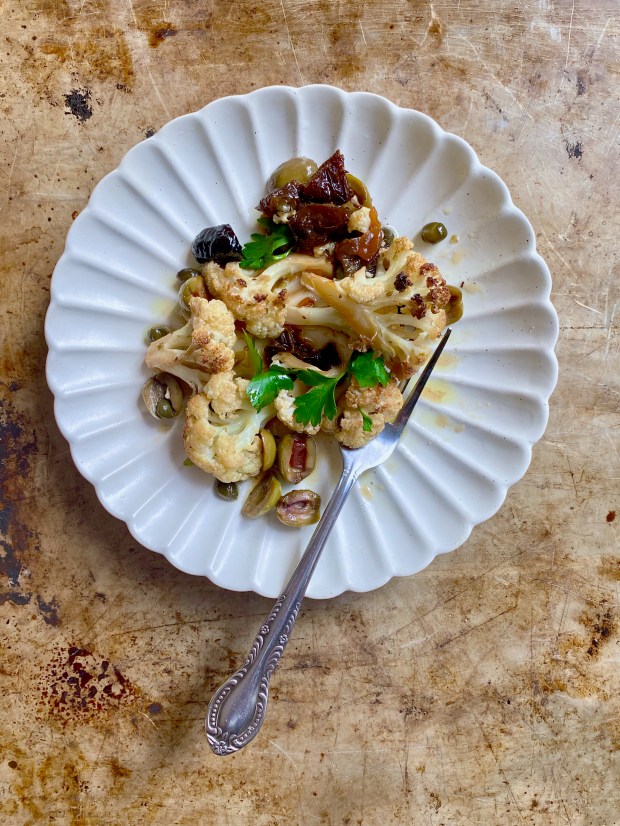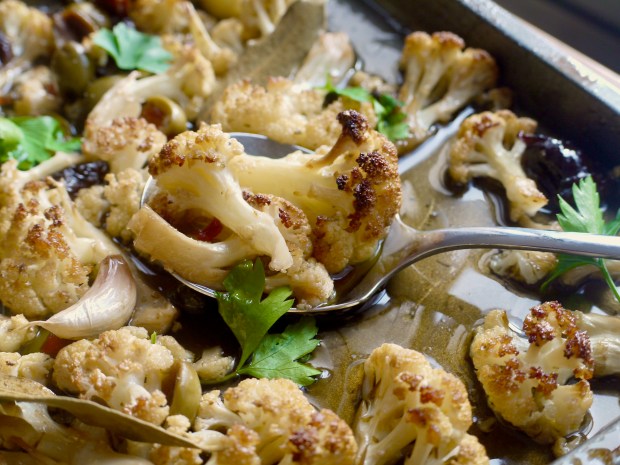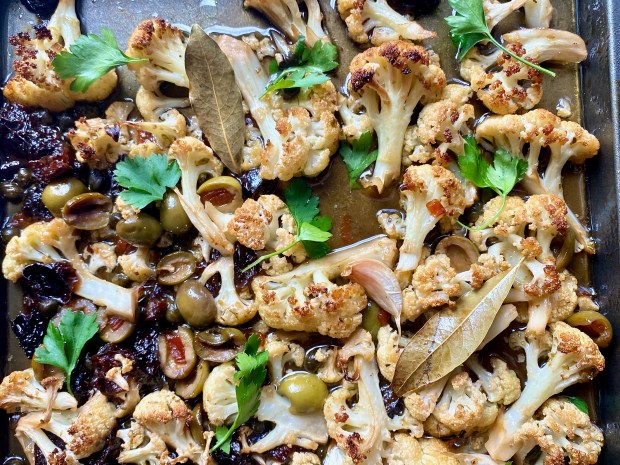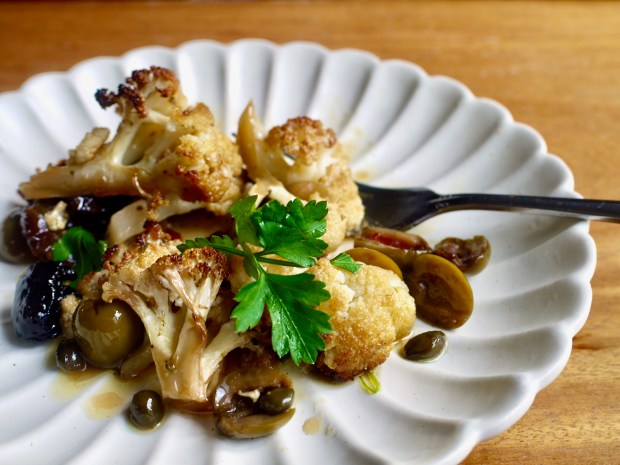
I am a woman of some few traditions; one of which is that every summer I reread Jilly Cooper’s 1988 novel Rivals, which got its hooks into me at a formative age and whose pages comfort despite my not particularly enjoying any of Cooper’s other books that I’ve tried. Maybe I should hastily add more intellectual titles that I’ve read to balance this admission, but whatever, my post-Christmas humid somnolence is simply not the same without this poorly-aged yet wildly scintillating book. And besides, Rivals is intellectual, with its characters quoting poetry off-book and enthusing over operas, and provides a treasure trove of 80s food references throughout its ceaseless parade of dinner parties and boozy lunches. And one such reference inadvertently influenced today’s recipe for Cauliflower Marbella.

Inadvertently because, due to my perpetual run-ins with the Mandela effect, I resolutely misremembered the Chicken Marengo that one of the characters cooked and thought (a) it was Chicken Marbella and (b) that the sauce would be a worthy framework for ingredients other than chicken and by the time I’d worked out this error of memory I was already elbow-deep in red wine vinegar and capers. But a path that is rocky is a path nonetheless and for my money this is the superior direction.

Chicken Marbella is — though not present in Rivals — a 1980s culinary landmark, first appearing in the Silver Palate Cookbook by Julee Rosso and Sheila Lukins, who ran a gourmet shop in New York. The delicatessen-counter ingredients are immensely appealing, balancing briny, sweet, and sour elements with the richness of olive oil. Cauliflower’s hearty creaminess welcomes these flavours, with the unfurling crevices of each floret seemingly made to drink them in, while still providing enough texture that this feels undeniably like a main course. Olives, themselves meatily-textured, jostle with ferrous prunes and tiny, salty capers, and the whole thing is rambunctiously yet elegantly delicious, as you’d expect from the decade of its provenance.
To that end I used chardonnay in the marinade-turned-sauce — I also happen to like chardonnay, the more oaky, buttery, and evoking learning of the stock market crash over a brick cellular phone the better — but you could replace it with dry vermouth for a less flamboyant approach. The quantities of olive oil, sugar, vinegar and wine are not insignificant, I grant you, but they harmonise beautifully and wouldn’t generate the same assertive flavour in lesser amounts. Besides which, this is a whole cauliflower we’re dealing with here.

I like this served with something to absorb the river of sauce — bread, or rice, perhaps — but its agrodolce qualities are also wonderful stirred through pasta, in which case you could consider toasting pine nuts or almonds to sprinkle over. I appreciate that these ingredients are maybe a little divisive, but they’re so particular that substitutions would render this dish void of its essential brazenness. For those of you who can’t countenance prunes and olives but still have cauliflower in the fridge waiting to be used, I suggest my Stovetop Buffalo Cauliflower Mac and Cheese, my Pickled Fried Cauliflower and Marinated Tofu Salad, my Sticky Sesame Peanut Cauliflower or my Double Cauliflower Salad.

Cauliflower Marbella
A reworking of the Silver Palate Cookbook classic that offers memorable flavour for very little effort. Indeed, you can put in even less effort by skipping the marinating step, making this brashly glamorous dish more weeknight-friendly. This is my variation but I referred to the Barefoot Contessa’s version of the original for particulars.
- 1 cauliflower
- 90g (1/2 cup) green olives
- 10 prunes
- 6 cloves garlic
- 2 tablespoons capers
- 2 teaspoons dried oregano
- 70g (1/3 cup) brown sugar
- 125ml (1/2 cup) olive oil
- 60ml (1/4 cup) red wine vinegar
- 180ml (3/4 cup) dry chardonnay
- 3 bay leaves
- A handful of flat-leaf parsley, to serve
1: Break your cauliflower into florets and chop each lengthwise into two or three pieces, and place them in a large non-reactive mixing bowl (eg one made of glass, china, or stainless steel). Tip the 1/2 cup of green olives and the ten prunes onto a chopping board and slice them all in half (removing any stones if they’re not pitted) and add to the bowl of cauliflower.
2: To the bowl, add the six garlic cloves (no need to peel), the two tablespoons of capers, two teaspoons of dried oregano, and the 1/3 cup brown sugar, then pour in the 1/2 cup olive oil, 1/4 cup red wine vinegar, and 3/4 cup chardonnay. Finally, drop in the three bay leaves. Carefully stir everything together, cover the bowl with clingfilm or a lid, and refrigerate for at least three hours, or overnight. (However, see notes if you’re in more of a hurry.) Take it out of the fridge once or twice to stir the cauliflower gently, just to ensure every floret gets the chance to be submerged, but it’s not the end of the world if you forget.
3: Once the marinating is done, set your oven to 180C/350F and tip the entire contents of the bowl into a shallow, rimmed baking tray or sheet pan, spreading the cauliflower out into an even layer. Bake for 35-40 minutes, turning the cauliflower over once with tongs halfway through. At this point the cauliflower should be browned around the edges and the marinade reduced down somewhat. Taste for seasoning — the olives and capers provide plenty of salinity but you’re welcome to add salt if it needs it.
4: Serve with your choice of accompaniments. You can squeeze the garlic cloves from their cases at this point and roughly mash them with a fork into the sauce, or leave them for people to consume whole as they find them.
How many this serves depends on how you dish it up — this is a hearty dinner for two with an accompanying starch but could stretch to feed four. It’s great over rice or with roasted or mashed potatoes, and I also love it stirred through pasta, in which case it can definitely feed more people. There’s so much going on in the sauce that you really just need something calm with absorbent properties to go with; a loaf of bread for dragging through the sauce would be perfect.
Notes:
- To make this right away without marinading, just mix everything together and jump straight to step 3.
- I used extremely bottom-shelf chardonnay here, but since you’ll have some leftover, make sure it’s something you’re happy to drink. If chardonnay doesn’t sit right with you, I’d replace it with dry vermouth or another dry white wine.

music lately:
What I Did For Love from A Chorus Line by Priscilla Lopez of the original cast. I saw a local production of this musical on Saturday and considering I never thought I’d get to see this live I was delighted and started crying from the moment they stood on the line holding their headshots. Despite sounding romantically-intended this is a love song to dance and yeah, you already know I’m crying again!
Anne’s Song by Faith No More, it lures you in with its goofy, conversational abstractness and then drops five different hooks all at once and then meanders on its way again. And so it should!
Aguirre I (L’acrime di rei) by Popol Vuh from the soundtrack to Werner Herzog’s Aguirre, the Wrath of God. Somehow a grippingly slow-moving film about a would-be coloniser’s descent into madness in 1560 and these spacious and atmospheric synths really work together and maybe if Aguirre himself had heard them he would have been a bit more chill about the whole process.


4 thoughts on “Cauliflower Marbella”